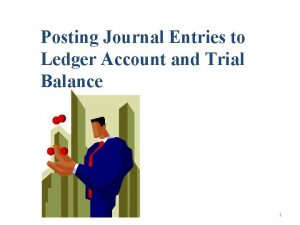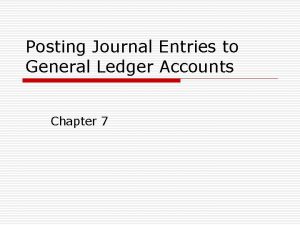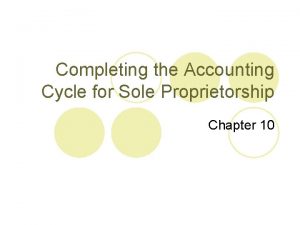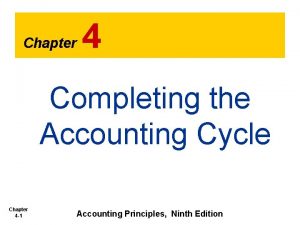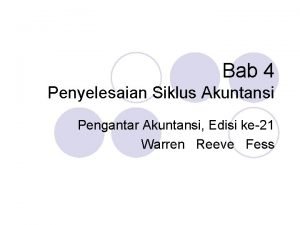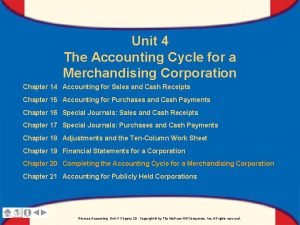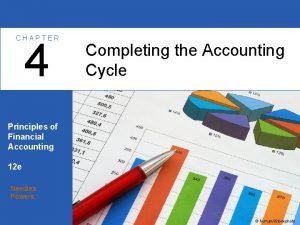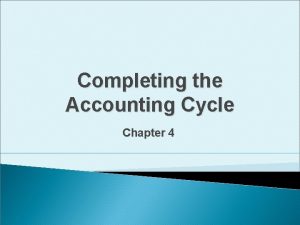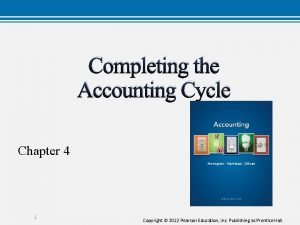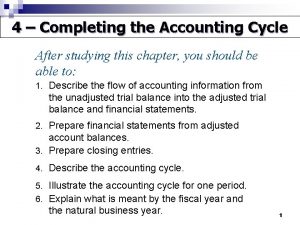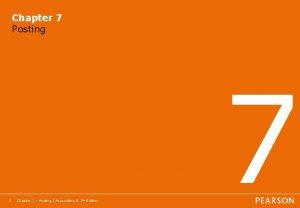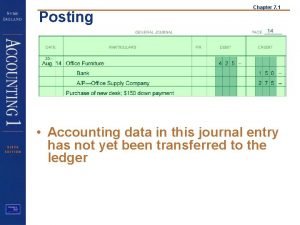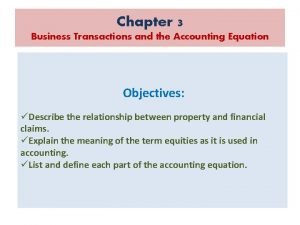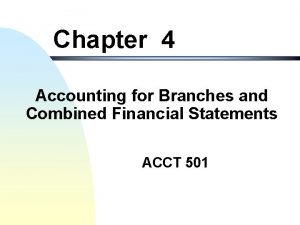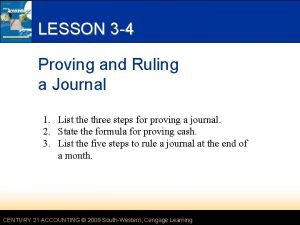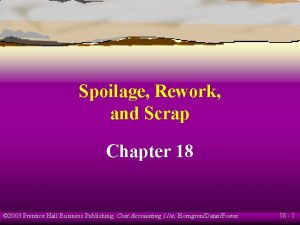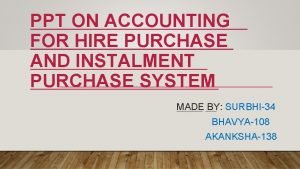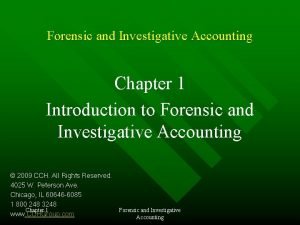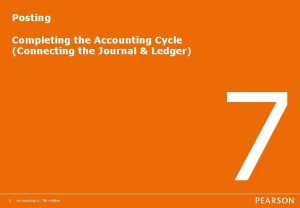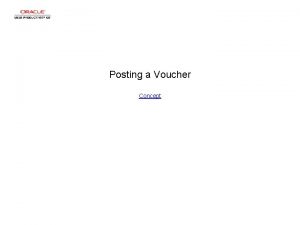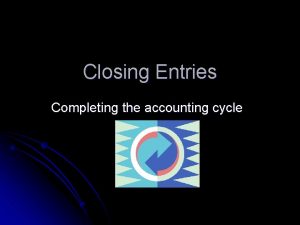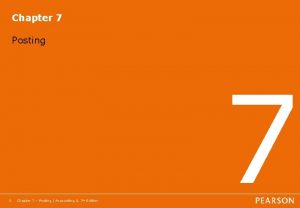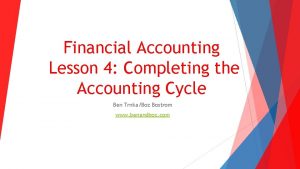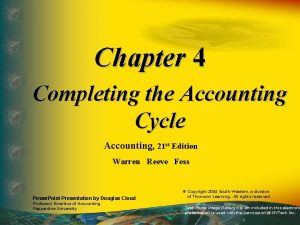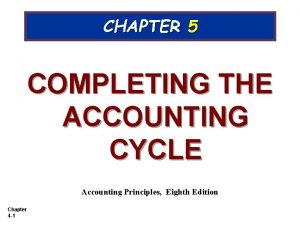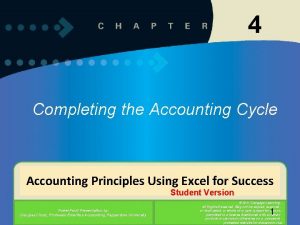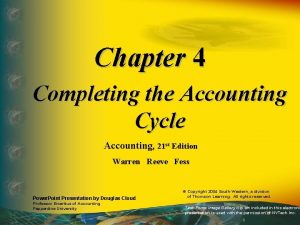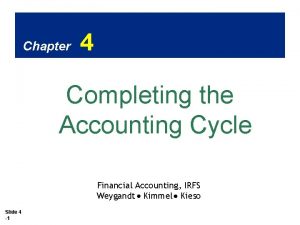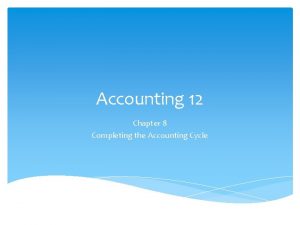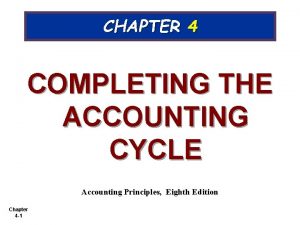Posting Completing the Accounting Cycle Connecting the Journal


















- Slides: 18

Posting Completing the Accounting Cycle (Connecting the Journal & Ledger) 1 Accounting 1, 7 th edition 7

Section Number 2 Title 7. 1 Posting 7. 2 Overcoming Errors 7. 3 Comparing Accounting Software Programs Accounting 1, 7 th edition

Section 7. 1 Posting refers to the transferring of information from the Journal to the Ledger PR – Posting Reference – This refers to: • The journal page that the information was copied over from (J 16) • 3 The ledgers account number that the information was recorded in (Bank 105 or A/R Jones 125) Accounting 1, 7 th edition

Section 7. 1 Posting The Balance Column Account – New Ledger Form • Refers to the new format used for the ledger • It looks like a Journal, but has a T-Account built into it What does it look like? How do we use it? How does it Connect to the Journal? 4 Accounting 1, 7 th edition

Section 7. 1 Posting Figure 7. 1: T-account vs. Balance Column Account 5 Accounting 1, 7 th edition

6 Steps of Posting 6 Accounting 1, 7 th edition

Section 7. 1 Posting New Procedures (Opening an Account): Account Title –The name of the new account that is accepting money (no pre-existing account) Account Number – Chronologically determined according to the Chart of Accounts 7 Accounting 1, 7 th edition

Section 7. 1 Posting New Procedures (Cross Referencing): Cross Referencing – the PR entry used for fact & error checking 8 Accounting 1, 7 th edition

Section 7. 1 Posting New Procedures (Forwarding): Forwarding Procedure – the process of continuing an account onto the next page or a new book 9 Accounting 1, 7 th edition

Section 7. 2 Overcoming Errors Owners, Bankers, Investors, Employees and Tax Authorities Rely on the information produced by accountants. This Trustworthy nature requires a High-Degree of Accuracy. Even though it may be human to make mistakes, an Accountant’s work must be Error-Free. Any error made must be caught before the books go public (Zero Tolerance – Due to Liability Issues) 10 Accounting 1, 7 th edition

Section 7. 2 Overcoming Errors Accounting Rule: Never Erase – Document All Changes Accountants use pen because mistakes are never erased (Suspicious) – Even software programs document any changes. 11 Accounting 1, 7 th edition

Section 7. 2 Overcoming Errors Found Immediately (Cross Out): Draw a single line through any mistake and write the correct figure or number immediately above 12 Accounting 1, 7 th edition

Section 7. 2 Overcoming Errors Found Later (Correcting Journal Entry): Use an accounting entry to correct an erroneous entry Example: Imagine that some supplies were purchased in January, but in the books the purchase was recorded in the equipment account instead. Also the mistake was discovered much later in July. 13 Accounting 1, 7 th edition

Section 7. 2 Overcoming Errors Found Later (Correcting Journal Entry): 14 Accounting 1, 7 th edition

Section 7. 2 Overcoming Errors Found Later (Correcting Journal Entry): 15 Accounting 1, 7 th edition

Section 7. 2 Overcoming Errors Figure 7. 12: Balancing the General Ledger 16 Accounting 1, 7 th edition

Section 7. 2 Overcoming Errors Single Error Tests (4 -Steps) 1. Multiple of 10 – Addition problem 2. Trial Balance Difference – A transaction in the Journal or Ledger was not handled correctly 3. (Trial Balance Difference) / 2 – Means an entry was posted in the wrong column (a Debit as a Credit or vice versa) 4. Trial Balance Difference is a multiple of 9 –means an entry was recorded out of order (i. e. 4598 was recorded as 4958) Transposition Error / Decimal Point Error 17 Accounting 1, 7 th edition

Section 7. 2 Overcoming Errors Multiple Error Tests (6 Steps) Must work Backwards through the Sequence of Balancing Steps Hint: Add…Check…Repeat: 1. Re-Add the Trial Balance Columns 2. Check the transfer of values from the Ledger to the Trial Balance 3. Re-Add the Ledger Accounts (Double Check the Dr / Cr Column) 4. Check the transfer of values from the Journal to the Ledger 5. Re-Add the Journal Entries (Make sure they balance) 6. Check the transfer of values form the Source Docs to the Journal 18 Accounting 1, 7 th edition
 Post ref in journal entry
Post ref in journal entry Problem 7-8 journalizing and posting business transactions
Problem 7-8 journalizing and posting business transactions Closing entries sole proprietorship
Closing entries sole proprietorship Completing the accounting cycle
Completing the accounting cycle Chapter 4 completing the accounting cycle
Chapter 4 completing the accounting cycle Completing the accounting cycle chapter 4 pdf
Completing the accounting cycle chapter 4 pdf Post closing trial balance merchandising
Post closing trial balance merchandising Chapter 4 completing the accounting cycle
Chapter 4 completing the accounting cycle Accounting cycle
Accounting cycle Chapter 4 completing the accounting cycle
Chapter 4 completing the accounting cycle Completing the accounting cycle
Completing the accounting cycle Accounting 1 7th edition chapter 7
Accounting 1 7th edition chapter 7 Posting in accounting
Posting in accounting Problem 3-2 accounting
Problem 3-2 accounting Dr cr balance sheet
Dr cr balance sheet State the formula for proving cash
State the formula for proving cash Abnormal spoilage journal entry
Abnormal spoilage journal entry Features of hire purchase system ppt
Features of hire purchase system ppt Journal of forensic and investigative accounting
Journal of forensic and investigative accounting
